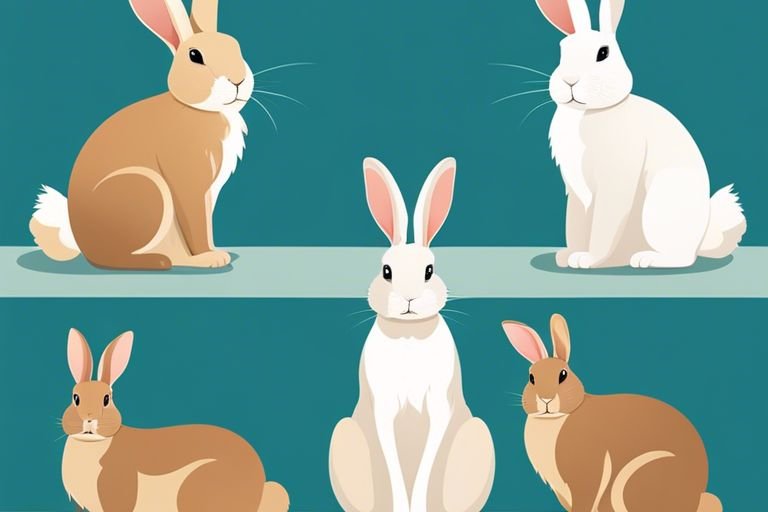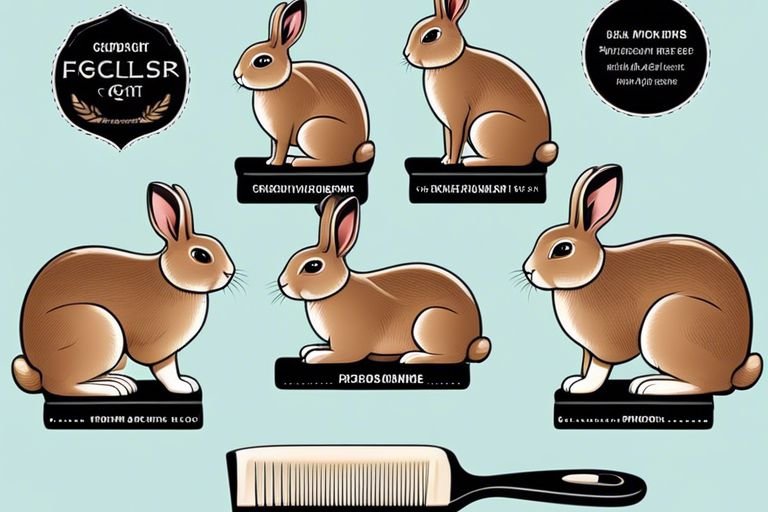As a Flemish Giant ages, its grooming needs undergo significant changes that require careful attention from the pet owner. These gentle giants have a specific set of grooming requirements that evolve as they mature, and being aware of these changes is crucial to maintaining their health and well-being. From managing shedding to addressing potential health issues, understanding how grooming needs change can make a positive impact on the life of your beloved Flemish Giant.
Key Takeaways:
- Increased grooming needs: As Flemish Giants age, they may need more frequent grooming to keep their fur and skin healthy.
- Special attention to nails: Older Flemish Giants may require more frequent nail trimming to prevent overgrowth and potential health issues.
- Monitoring dental health: Dental issues can become more common as Flemish Giants age, so it’s important to keep a close eye on their dental health and provide appropriate dental care.
- Regular health check-ups: As they age, Flemish Giants may be more prone to health problems, so it’s important to schedule regular check-ups with a veterinarian to monitor their overall well-being.
- Adjusting grooming techniques: As their mobility and flexibility may change, it’s important to adjust grooming techniques to be gentle and accommodating to their changing needs.
Grooming Needs in Flemish Giant Kits
Assuming you have a Flemish Giant kit, it’s essential to understand their grooming needs from a young age. The grooming requirements of a young rabbit are different from those of an adult rabbit. It’s important to be aware of these differences to ensure the health and well-being of your furry friend. For more information on the lifespan of Flemish rabbits, check out How Long Do Flemish Rabbits Live? The Complete Guide.
Nutritional Considerations for Coat Health
The nutritional needs of young Flemish Giant rabbits are crucial for maintaining a healthy coat. The diet should consist of high-quality hay, fresh vegetables, and a small amount of pellets. The hay helps to wear down the teeth and provides essential fiber for the digestive system, while the vegetables and pellets offer a wide range of essential nutrients for the overall health of the rabbit, including the condition of the coat.
Grooming Techniques for Young Rabbits
The key to grooming a young Flemish Giant rabbit is to start early and make the experience as positive as possible. Handle the rabbit gently and introduce it to brushing and nail trimming in a calm and relaxed environment. The sooner the rabbit becomes accustomed to the grooming process, the easier it will be to maintain the health of the coat as it grows older.
Plus, regular grooming sessions will help build a bond between you and your rabbit, leading to a happier and more relaxed pet. It also gives you the opportunity to monitor the condition of the rabbit’s coat and skin, allowing you to spot any potential issues early on. Key points to remember while grooming young rabbits include gentle handling, positive reinforcement, and consistency.
Adolescent Flemish Giants and Grooming
One of the key aspects of caring for an adolescent Flemish Giant is understanding their grooming needs. As these rabbits go through their adolescent stage, their grooming requirements may change and it is important for owners to be aware of these changes in order to take proper care of their beloved pets.
Adapting to Rapid Growth
One of the primary grooming needs for adolescent Flemish Giants is adapting to their rapid growth. During this stage, these rabbits experience significant growth spurts, which can result in changes to their fur texture and density. Owners should be prepared to brush their rabbits more frequently, as their shedding patterns may also change. Additionally, regular grooming can help prevent matting and tangling of their fur as they grow.
Adolescent Flemish Giants require extra care and attention to ensure they remain healthy and comfortable during this period of rapid growth. By adapting their grooming routine to accommodate their changing fur and shedding patterns, owners can help their rabbits maintain a healthy and sleek coat.
Grooming to Mitigate Common Health Concerns
One of the key reasons for maintaining a diligent grooming routine is to mitigate common health concerns that may arise during the adolescent stage of a Flemish Giant. As these rabbits grow, they may be more prone to developing skin issues, such as mites and dermatitis. Regular grooming sessions provide an opportunity for owners to thoroughly inspect their rabbit’s skin and coat, allowing them to identify and address any potential health issues early on.
Grooming also plays a crucial role in preventing the buildup of dirt and debris, which can lead to infections and discomfort for adolescent Flemish Giants. By keeping their fur clean and well-maintained, owners can help their rabbits stay healthy and happy throughout this crucial stage of development.

Adult Flemish Giant Grooming
Not only is grooming important for maintaining the health and appearance of your Flemish Giant, but it also provides an opportunity for bonding with your pet. As adult Flemish Giants grow, their grooming needs also change, requiring a different approach compared to when they were younger.
Maintenance and Routine Grooming Practices
For maintaining the coat of an adult Flemish Giant, regular grooming is essential. This includes brushing the coat to help remove loose fur, dirt, and prevent matting. Additionally, nail trims should be done as needed to prevent overgrowth and potential issues with mobility. It is important to establish a routine for grooming to help your Flemish Giant become comfortable with the process and reduce any stress associated with it.
Addressing Age-Related Grooming Challenges
For an aging Flemish Giant, grooming may become more challenging due to decreased mobility and flexibility. As a result, you may need to adjust grooming techniques and provide additional support to your pet during grooming sessions. Additionally, older Flemish Giants may develop skin and coat issues that require specialized care and attention.
With the proper maintenance and attention to age-related grooming challenges, you can ensure that your adult Flemish Giant remains healthy and comfortable as they age.
Senior Flemish Giants and Special Grooming Care
After years of being a beloved member of your family, your Flemish Giant may start to show signs of aging. As they enter their senior years, it’s important to adjust your grooming routine to cater to their changing needs. Providing special grooming care for senior Flemish Giants can help them stay comfortable and healthy as they age.
Recognizing Signs of Aging in Flemish Giants
Flemish Giants, like all animals, go through physical and behavioral changes as they grow older. As your Flemish Giant ages, you may notice a decrease in their activity level, changes in their appetite, and even the development of gray hairs around their muzzle and eyes. Paying attention to these signs can help you recognize when it’s time to adjust their grooming routine to accommodate their evolving needs.
Customizing Grooming for Comfort and Health
Giants that are aging may experience mobility issues, arthritis, or other health concerns that require special grooming care. Customizing your grooming routine to provide gentler handling, shorter grooming sessions, and specialized tools can help your aging Flemish Giant stay comfortable and healthy. For example, using a soft brush and being mindful of any tender areas can prevent discomfort during the grooming process.
Health is of the utmost importance when customizing grooming for senior Flemish Giants. Keeping their fur clean and free of mats can help prevent skin issues, while regular nail trims can prevent overgrowth and discomfort. Paying attention to their changing grooming needs can help you address any health concerns and ensure they stay happy and comfortable in their senior years.

Conclusion
Following this discussion, it is clear that the grooming needs of a Flemish Giant rabbit change as they age. While younger rabbits may require more frequent grooming to manage shedding and prevent matting, older rabbits may need assistance with grooming due to mobility issues and declining health. It is important for rabbit owners to stay attuned to these changing needs and provide appropriate grooming care as their Flemish Giant matures. Regular grooming can promote the overall health and well-being of the rabbit, ensuring that they remain comfortable and happy as they age.
FAQ
Q: How do grooming needs change as a Flemish Giant ages?
A: As Flemish Giants age, their grooming needs change due to factors such as a decrease in agility and ability to groom themselves, leading to a higher likelihood of matting and soiling. It is essential to regularly groom older Flemish Giants to prevent health issues such as skin infections and discomfort.
Q: What specific grooming practices should be focused on for older Flemish Giants?
A: For older Flemish Giants, grooming practices should include regular brushing to prevent matting, cleaning and trimming of nails to prevent overgrowth and discomfort, as well as keeping the ears and eyes clean to prevent infections. Additionally, regular checking of the skin for any issues like lumps or growths is crucial.
Q: How often should older Flemish Giants be groomed?
A: Older Flemish Giants should be groomed on a more frequent basis compared to when they were younger. This may involve daily brushing to prevent matting, and regular nail trims every 4-6 weeks to prevent overgrowth. Additionally, regular inspection of the ears, eyes, and skin should be done during grooming sessions. It is important to consult with a veterinarian to establish a grooming routine that is suitable for your individual Flemish Giant’s needs as they age.
